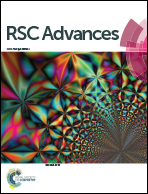Mixed-halide triphenyl methyl radicals for site-selective functionalization and polymerization†
Abstract
Derivatives of the stable, luminescent tris-2,4,6-trichlorophenylmethyl (TTM) radical exhibit unique doublet spin properties that are of interest for applications in optoelectronics, spintronics, and energy storage. However, poor reactivity of the chloride-moieties limits the yield of functionalization and thus the accessible variety of high performance luminescent radicals. Here, we present a pathway to obtain mixed-bromide and chloride derivatives of TTM by simple Friedel–Crafts alkylation. The resulting radical compounds show higher stability and site-specific reactivity in cross-coupling reactions, due to the better leaving group character of the para-bromide. The mixed halide radicals give access to complex, and so far inaccessible luminescent open-shell small molecules, as well as polymers carrying the radical centers in their backbone. The new mixed-halide triphenyl methyl radicals represent a powerful building block for customized design and synthesis of stable luminescent radicals.



 Please wait while we load your content...
Please wait while we load your content...